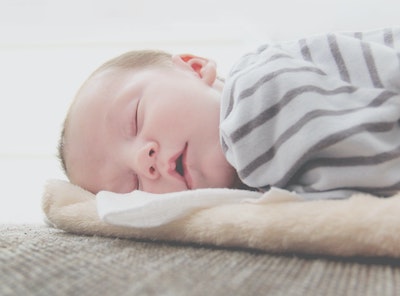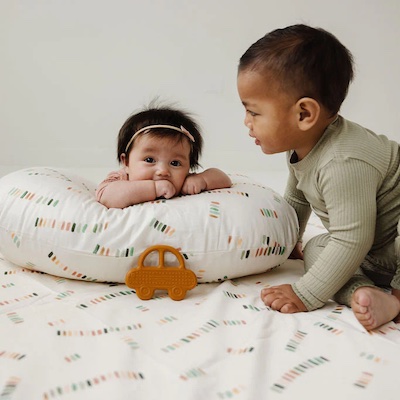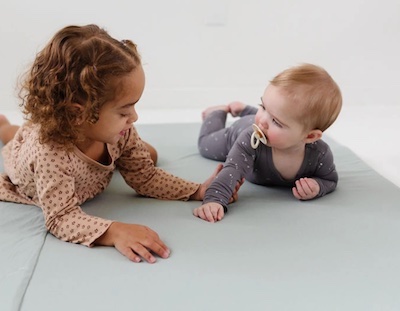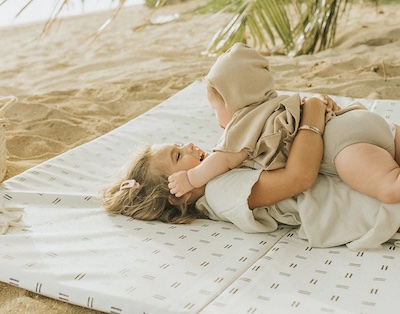
Article by Jessica Pierce – Registered Nurse & Nationally Registered Paramedic
You’ve done it – baby is finally sleeping!
… on their play mat… on the floor.
(Cue dramatic music) Is this safe?!
You’re not the only mom concerned about this – lots of parents asks this question.
It’s hard enough to get a new baby to sleep, let alone get a good night’s sleep yourself. Is it okay if they sleep on the floor, or anywhere else besides their crib?
Keep reading, because we’re about to dive into the ins and outs of daytime naps to clear up what’s safe for your baby.
This article is not a substitute for medical advice.
Can My Baby Safely Sleep On The Play Mat?
Here’s what the baby experts are saying about letting baby sleep on the floor:
Some experts say that naps on the playmat are perfectly safe – as long as baby is supervised by a parent while they sleep and the environment is clear of any potential hazards.
This means you need to make sure baby is on a hard surface (i.e. the floor) and not close to any blankets, pillows, cords, or curtains to prevent them from accidentally suffocating or choking.
Another key consideration is that play mats may be made out of different materials than regular bedding: Toki Mats1, a mom-owned play mat brand, states that play mats are not treated with frame retardants2 as it is required for sleep products like mattresses3.
And even if they are 100% breathable and self-ventilating they are not a subject to rigorous safety tested like cribs, bassinets or pack n plays.

Even if your baby falls asleep and takes a nap on the play mat, you should never leave your child alone and unsupervised when sleeping on the play mats.
I would recommend transition your baby to crib/bassinet/pack n play once you notice they fell asleep on the playmat or floor.
If you’re concerned about the safety of any kind of bedding or sleeping arrangement for your baby’s sleep, it may be helpful to talk with your pediatrician about your concerns and any potential dangers.
Baby’s Sleep Safety Guidelines
Here are some of the best pediatrician recommended tips for making the sleeping area safe for baby:
Always, always, always, put baby to sleep on their back. Sleeping on the stomach has historically been linked to an increased risk for SIDS (sudden infant death syndrome). It’s also easier for babies to suffocate when sleeping on their stomachs.
Keep toys and pillows out of the crib at night. Let your baby sleep in a sleep sack or onesie, but don’t put them to sleep in a hat or hooded outfit as any of these items can also suffocate your baby.
Make sure baby doesn’t get overheated by putting them to bed in breathable, comfortable pajamas. If you use a blanket, try tucking it under the foot of the mattress to keep it from riding up over baby’s face and head during while they’re sleeping. However, according to AAP it’s best to avoid any blankets in your baby’s sleep space, at least in the first 12 months.
Baby’s sleep will be better on a mattress that is firm and thin. If you want your baby to sleep in your room, put them in a crib or bassinet next to your bed. Avoid letting them sleep in bed with you, as this has been shown to pose a suffocation hazard.
Always be aware of where babies are sleeping or playing. Carpets in the home can contain dust or germs that might harm young children, and unless all your furniture is padded, rolling into a sofa or table could create a dangerous situation for baby.
If your little one spends a lot of time on the floor, keep it clean as much as possible, and make sure the sleeping surface is flat to avoid injury if your baby rolls over. You wouldn’t want your little one to play or sleep on the floor if it’s dirty, right?
Another key is choosing a non-toxic playmat free from harmful chemicals that could have adverse effects on your baby. This article lists a variety of non-toxic and even organic playmat brands that are mom-approved!
Especially if your playmat gets heavy use, make sure to clean it frequently to prevent the growth of bacteria or fungus that could potentially harm your baby.
Is It OK For Baby To Nap On The Floor?
Here are some pros of letting your baby sleep on the floor:
- A playmat on the floor provides a firm, flat surface where baby can safely sleep while parents keep an eye on them.
- It’s so much more convenient to let your baby sleep when they’re tired without the hassle of trying to get them into their crib while desperately trying not to wake them up.
And some reasons why it might not be the best:
- Play mats have not been tested like cribs, bassinets or pack n plays which are designed for sleeping. This means they are safe for playing, but it’s hard to assess their safety for sleeping and napping.
- Play mat may feel supportive and firm for play time, but it may not be sufficient for sleep time.
- It’s easier for baby to get hurt if they roll off the playmat onto carpet or floor, or into furniture.
- Pets and other children could wind up accidentally hurting a baby if they sit, trip over, or lay on top of them.
- The floor isn’t a great place for babies to sleep at night. For over night sleep, put baby in their bed with a firm mattress and a tight fitted sheets. No bedding is needed, just dress your little one appropriately to your room temperature (in onesie, PJs, swaddle, or sleep sack).
- It may be convenient to let them sleep where they are, but carpets and play mats are not the place for baby to sleep safely (germs + higher risk of injuries and SIDS).

When Can I Put My Newborn On A Playmat?
The overwhelming pediatrician recommendation is to start tummy time as soon as your baby comes home from the hospital, as it has many benefits. Always make sure that baby is supervised by a caregiver, and awake while positioned on their stomach.
Putting baby on their belly is especially important because it prevents flattening on the back of baby’s head caused by too much time laying on their back.
Some sources suggest placing a soft pillow under your baby’s head to prevent this, but having pillows close to baby’s face poses a significant safety risk, so the hazards of this practice definitely outweigh any potential benefits.
Allowing your baby to explore on the floor playmat promotes independence while keeping your little one safe and comfortable. These are just a few of the many benefits of playmats!

How Long Can My Baby Lay On The Playmat?
It’s recommended to start with one to three minute sessions on the floor playmat, two or three times a day. This can be increased with age as baby grows to enjoy being on their stomach!
Babies are all different, and some may not enjoy being on their stomachs as much at first. Provide age appropriate toys to help baby enjoy playmat time, and don’t worry if they aren’t ready to spend a lot of time on the floor right away.
Best Activities For Babies On The Play Mat
Playmats have many benefits for babies during the awake time. Here are some tips to get the best use out of yours!
Playmats are absolutely fantastic for tummy time! This is a great way to foster baby’s independence while providing a safe space to explore and develop.
This is a great time for parents to play and interact with their baby. Lay the mat (or a blanket) out in the middle of the floor, clear from furniture. Play some music, shake their favorite rattle, or read them a book.
Play time on a playmat strengthens head, neck, and core muscle groups while prompting baby to learn new skills like picking their head up or rolling over. Over time, this helps them get ready for bigger things like crawling, sitting up, and eventually walking!

Feel any better yet, parents? You’re not a bad mom or dad if you let your baby fall asleep on the floor or playmat every once in a while. If you’ve taken the proper steps to keep the sleep space clear, you can rest in peace as you watch your baby safely sleep.
Article By Jessica Pierce, RN
Jessica Pierce is Registered Nurse, Nationally Registered Paramedic, writer, and contemporary dance artist based in Tulsa, Oklahoma. She holds two undergraduate degrees from Oral Roberts University – a Bachelor’s of Science in Nursing (2018) and a Bachelor’s of Art in Dance Performance (2019).
The purpose of this article is informative. It’s not a substitute for professional medical advice or medical care. Remember: safety first! Consult your doctor/pediatrician in case of any doubts. The author of this article does not accept any responsibility for any liability, loss or risk, personal or otherwise, incurred as a consequence, directly or indirectly, from any information or advice contained here.
Pictures of playmats belong to Toki Mats.

